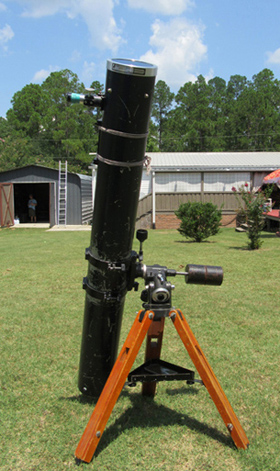
October 2017 - Vol. 21, No. 10
This Month's Night Sky - NOTE: The next paragraph describes the sky as it appears at 10 pm EST (11 pm EDT) near mid- month. The sky also looks this way at 11 pm EST (midnight EDT) during the beginning of the month and at 9 pm EST (10 pm EDT) by month's end.
Although the Summer Triangle is still visible in the W, the Square of Pegasus is now prominent high in the S. Far below, lonely Fomalhaut [FOE-ma-lot] of Piscis Austrinus still glitters near the S horizon. Between Pegasus and the N pole star, Polaris (Ursa Minor), find the familiar "W" shaped asterism of Cassiopeia. If you are fortunate to be viewing from a dark site, you will also see the constellations, Perseus and Auriga, with its bright star, Capella, embedded in a starry band stretching across the night sky from E to W. You are looking at the Milky Way, actually one of the spiral arms of our galaxy. In the E the constellations, Gemini, with its bright twin stars, Castor and Pollux, and Orion, with its distinctive hour glass asterism, rise above the E horizon. Now the Big Dipper (Ursa Major) dips low in the N.
MERCURY is poorly placed for most of the month, reaching superior conjunction on the 8th to re-emerge in the evening sky late in the month. VENUS also shines in the morning sky losing magnitude and closing on the Sun toward superior conjunction early next year. Look for Venus near Mars on the 5th. MARS in the morning sky in the constellation Virgo reaches aphelion on the 7th. The red planet's disk is a mere 3.7" in diameter and magnitude will be only 1.8 effectively making it a 2nd magnitude planet. JUPITER quite low in the evening sky may not be visible for most observers as it reaches conjunction on the 26th. SATURN sets in the evening this month. URANUS is at opposition on the19th, at 5.7 mag it may be visible to sharp eyed observers at dark sites. NEPTUNE will be in the sky most of the night this month in the constellation of Aquarius.
Review how to determine Angular Measurement.
Calendar of Events
NOTE: For those observers not in the ET zone, convert the calendar times to your zone's time by subtracting one hour for CT, two for MT and three for PT. Don't forget to adjust for Daylight Savings Time when necessary by subtracting one hour from your planisphere's time. Dawn and dusk times must also be corrected. See your local newspaper, TV news, or cable TV's Weather Channel for sunrise and sunset times or check with the U.S. Naval observatory. Unfortunately some of these events may occur during daylight hours in your area.
| DATE | EVENT |
| 03 | Neptune .7 deg N. of Moon occultation from Antarctica, New Zealand, and SE. tip of Australia. |
| 05 | Venus .2 deg N. of Mars. This month's full moon is also called the Harvest Moon, that is the full moon closest to the autumnal equinox. |
| 07 | Mars at aphelion. (farthest distance from the sun in its orbit.) |
| 08 | Draconid meteor peak. Draconids originate in the northern sky, so this is a northern shower best seen in the evening sky when the radiant is at its highest. The hourly rate is low but on rare occasions an outburst may occur. |
| 09 | Aldebaran 0.6 deg S. of the Moon occultation from parts of Asia, Alaska, and NE Canada.
Moon at perigee. |
| 15 | Regulus .2 deg S. of Moon, occultation from North America below Canada, Carribean, Cape Verde, and W. Africa. |
| 17 | The Zodiacal Light or "false dawn" is visible in the E about 2 hours before sunrise for the next two weeks. This pyramidal glow is caused by meteoroids, dust particles spawned by passing comets, etc., that have settled into the ecliptic plane (path followed by the Sun, Moon and planets), reflecting the Sun’s light before it rises here.
Mars 1.8 deg S. of Moon. |
| 19 | Uranus at opposition located in Pisces. |
| 18 | Venus 2 deg S. of Moon. |
| 21 | Orionid meteor peak. This shower produces up to 20 meteors per hour. The Moon will be but a slender crescent setting early for this year's shower, so keep a sharp eye out around this date if you are out in the wee hours observing. |
| 24 | Saturn 3 deg S. of Moon. |
| 25 | Moon at apogee. |
| 26 | Jupiter in conjunction with Sun. |
| 29 | Mercury at aphelion. |
| 30 | Neptune .9 deg N. of Moon, occultation from Antarctica and S. tip of Africa. |
Lunar Almanac for October 2017
| Phases of the Moon | Phase and Date(s) | Best viewed before local midnight |
 |
New 19 |
Deep Space Objects |
 |
1st. Qtr 27 |
Planets & Moon |
 |
Full 05 |
Moon |
 |
Last Qtr 12 |
Deep Space & Planets |
Topic of the month: Total Solar Eclipse August 21, 2017 U.S.A.
August 21, 2017 - Total Solar Eclipse - Gilbert, SC
In a departure from usual sky lore or technical information, I am happy to include the details of my observational session of the total solar eclipse. I was fortunate that my niece and her family live in Gilbert, SC, a small town that is less than 2.5 square miles and close to the centerline of the umbral path. This story and others will appear in Astra's Guide to the August 21, 2017 Total Solar Eclipse.
Data for Gilbert, SC
2m 35.9s TotalityStart of Partial: 13:12
Totality: 14:41 – 14:44
End of Partial: 16:06
In the small town of Gilbert, SC, west and south of the capital city of Columbia, the day began with a sky that was amazingly clear and blue. The soil is sandy and the only noticeable insects in the day time are the industrious fire ants whose nests are numerous. There are few birds during the day in the yards, although there many be plenty in the patches of pine groves when the sun is high. I really didn't notice any activity during the eclipse but my companions. Family members graciously opened their homes and their yards for astronomical activity. As long as there were no clouds, we saw the Milky Way every night after sunset. The yard we observed from is spaceous and fenced in with plenty of room to set up our scopes and observe the eclipse with family. We had brought our portable observing chairs, a set of two connected chairs that fold up and fit into a matching carry-all bag.
We set up the scope first and allowed our equipment to equalize with the ambient temperature. Eclipse day was not quite as humid as the previous 2 days we were in Gilbert, but it was still hot ( ~ 94 deg F. ) The scope is a 6” f/9.6 reflector, with a tube about 5 ft. long. I ground the mirror back in the last millennium. We’ve used this scope to observe 3 solar eclipses as I write this account. Its first total solar eclipse was in 1991 where we observed near the centerline in Baja California, Mexico. Totality for that eclipse lasted almost 7 minutes. We used a Thousand Oaks glass solar filter and about 50x to observe this eclipse. I believe it is a fine instrument, an excellent planetary scope that also performs well on deep sky objects. I may be prejudiced, but there is nothing like observing through an instrument you made with your own hands. We had a second telescope set up, a 3” refractor belonging to my brother Don. I was able to use the 3" refractor on the 1998 total solar eclipse from Antigua island in the Carribbean.
As we moved closer to the P1 first contact, the sky was blotchy with clouds. As 1:13 approached those clouds began to seem a little ominous. I peered at the sky and watching closely, finally saw first bite at 1:12 according to my phone although I don’t think I saw the instant of contact. After about 10 minutes the cloud passed and the sun was clear for rest of the eclipse.
The Moon marched steadily across the Sun. Sunspots helped to measure its progress. The craggy mountains on the lunar limb stood out profoundly on the solar disk. Our site’s close proximity to the centerline made the moon appear close to center. While the eclipse progressed, we played with shadows, projecting the moon covered solar disk using colanders and my niece’s straw hat that worked amazingly well. As the eclipse progressed, the temperature dropped off and the clouds dimmed and grew pinkish. Soon the shadows were not so sharp. As totality grew close our whole site took on some eerie not-twilight color.

Then suddenly, totality! The first diamond ring heralding P2 was fabulous, but soon gave way to Baily's beads and then the corona. In the early stage I saw the red chromosphere, as I had planned to look for just when totality began. Venus popped out immediately, you just couldn’t miss her. In the scope, the prominences danced out from behind the moon. I didn’t see Mars or Mercury, but the 3” refractor revealed Regulus. I couldn’t believe how close it was to the Sun and Moon. Was that really 1 degree? The corona was beautiful, white and gorgeous. I was looking through the telescope again when the Sun peaked out from behind the moon. Yes, I saw the second Diamond Ring through the scope. I pushed the tube away and grabbed my solar filter glasses. It was over! But, my what a fantastic show!

The white corona was smaller than I remembered from my 1991 eclipse. Back to the filters, we began to watch the Moon’s retreat. As the Moon continued her journey, the surface of the solar disk was slowly revealed. Sunspot group AR12971 popped into view. The first member of this group was dark and uninteresting, but the next group of blotches carried a wealth of information to the eye. This second group had so many small members, I couldn’t count them. The spots were numerous, surrounded by ghostly outlines. Appearing against the dark lunar shadow, the obscuration of the rest of the group made this piece of the group stand out proudly on the solar disk.
All too soon, last bite. My phone read 16:05 giving me about 2 hours and 50 minutes of eclipse for the August 21, 2017 total solar eclipse. The event of a total solar eclipse always leaves me with a sense of awe and profound admiration for God’s handiwork.
Lastly, this image of the active sunspot region ia avaliable at spaceweather.com. NASA/SDO observatory is the owner of the original, although this version was modified for Astra's Star Gate. Sunspots make telescopic observing a solar eclipse even more fantastic! Here is AR12671 as it appeared on August 21, 2017:

--See You Under the Stars!
Astra for Astra's Almanac
This installment of "What's Up?" is ©2017 by Dawn Jenkins for Astra's Stargate. View Ron Leeseburg's Farewell Issue for information on where to find information such as is presented in this almanac.
